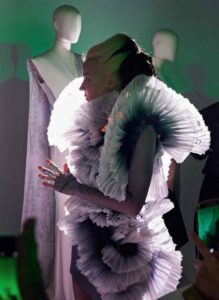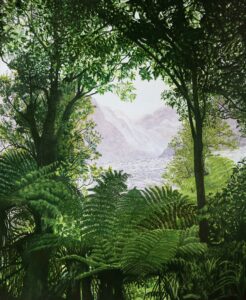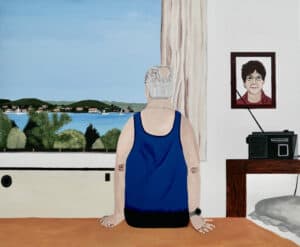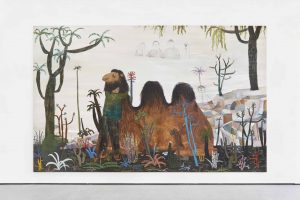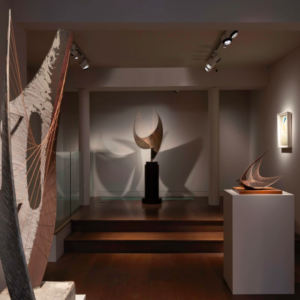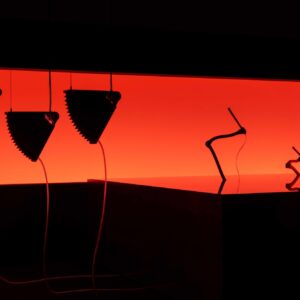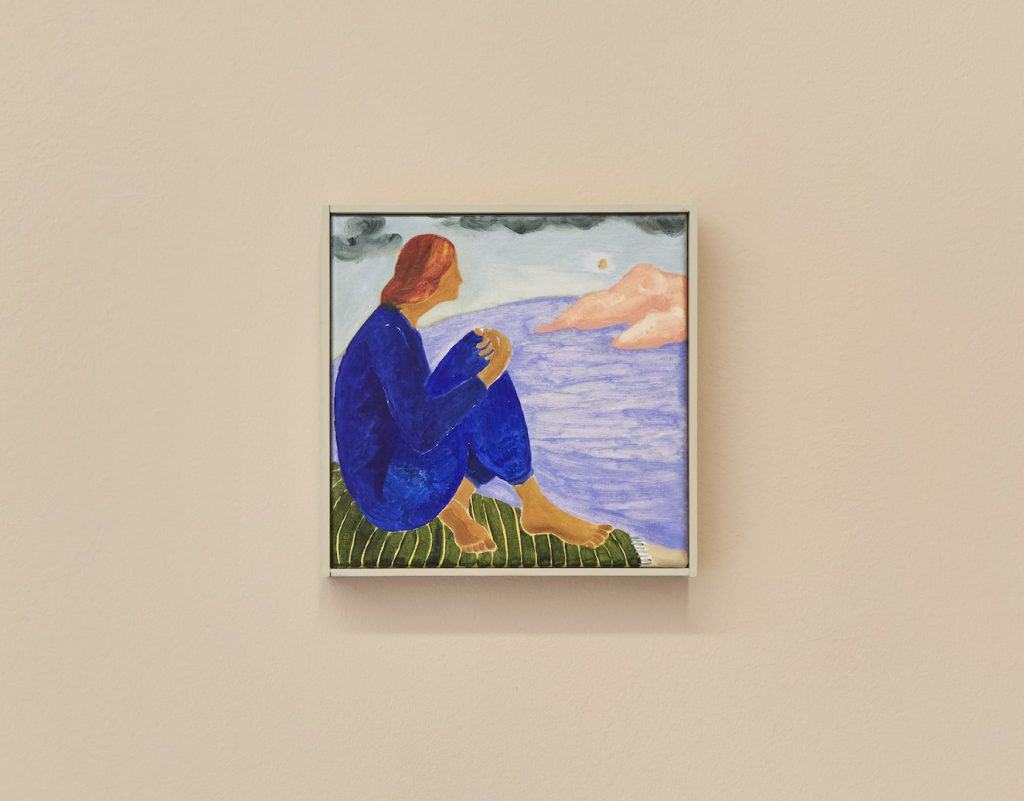
London-based artist Freya Douglas-Morris recently sat down with art historian, writer and curator Hector Campbell to discuss her interest in memory, physical approach to art-making, experience as a mother, and her current solo exhibition ‘All paths lead somewhere’ at Lychee One in London Fields, which runs until June 25th.
Hector Campbell: Having graduated from Brighton University with a BA in Fine Art in 2002, you went on to complete an MA in Painting at the Royal College of Art over a decade later. What drew you back to arts education after a prolonged period as a practising painter? And how did your practice develop during your time at the RCA?
Freya Douglas-Morris: I had always had it in the back of my mind that I wanted to do an MA, especially on a course that focused so much on painting. But I also knew that I needed some time to find my own way of working before I started an MA. For me the years in between were really beneficial, I had time to make my work in my own way, exhibit and discover what my strengths and weaknesses were before starting. Of course, in some ways it is harder to have a period of time in between as there is more to dismantle, but once I joined the MA I really wanted that process and intervention in my practice. It was dynamic and challenging and I think coming at it from the perspective of someone who had already had some years in a studio outside of education, I really valued the conversations and feedback.
In terms of development, I think the MA challenged the way I approached my imagery and initial source material, and the paintings changed as a result. The most important development for my work was that I started working on paper, which opened up a way of working more quickly, fluidly, intuitively and spontaneously.
Your picturesque paintings regularly depict luscious landscapes – often dense forests of towering trees, rolling mountainous horizons and sandy shores – and your MA dissertation entitled ‘From the Lands of the Lemon Tree: Journey and the Image’ explored the comparisons between travel and art-making. To what extent do your paintings portray authentic, visited locations? And are there particular places you have travelled to that continue to influence your practice?
I find the idea of the authentic quite interesting. What makes something authentic? Does it only belong to an actual visited and lived experience, or can there be a sense of something being authentic even if it is partly imagined? If there is a leaning on memory and a belief in the scene, landscape, figures? I am of the consideration that a painting can still be considered authentic even if the resulting image is concocted out of disparate parts – some realised and some imagined.
I once went to Central and South America for 6 months, it was the longest and farthest I have been away and in many ways that trip was pivotal in informing the landscapes I paint. I began to develop a dictionary of pictorial references that fed into the work and that still remains a staple part of my imagery to this day. However, the direct references have shifted. Where once I would look at photographs and source material at the start of a painting, I now rarely, if ever, look at something directly. I have grown into my way of constructing images so that the components of the landscape are internal, they are more felt and fluid. Each painting lends itself to the next and with this way of working the construction of the image arrives without too much external influence. I am more likely to look at films, other painters or read song lyrics for inspiration than I am a direct image.
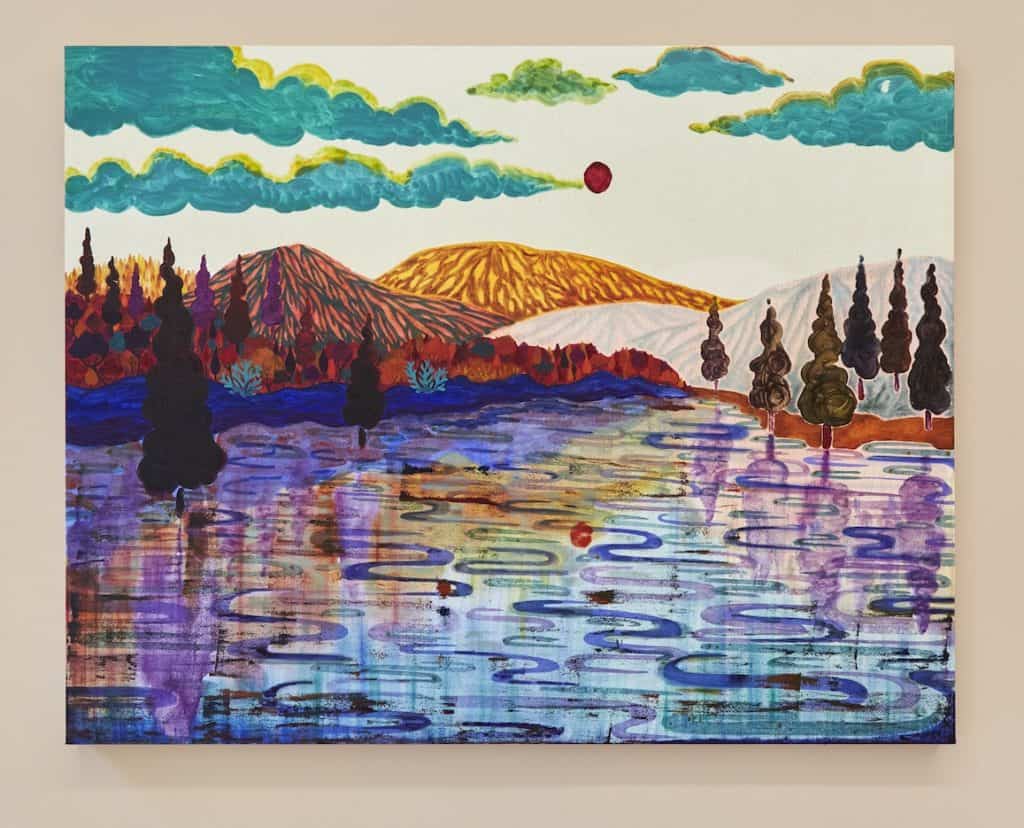
I understand that the preservation of memory and the concept of memories altering and evolving over time is of particular interest to you, and you’ve spoken before about maintaining a ‘memory bank’ of imagery that you can draw from for inspiration. Could you speak further to some of these more conceptual underpinnings of your practice?
I am so interested in how we remember things. At the moment, I am finding that memories of things attached to childhood are more relevant in my work; I am not sure if this is a result of the internal world of lockdown that we have all shared, or if it is becoming a mother in the last few years and reflecting on what a memory is, the impact of memory and how it shapes us, but I am finding that I am currently remembering things that I haven’t thought about for 20 years. It’s like an old window being opened again.
The idea of compiling and cataloguing memories has always played a role in my practice. I do have a collection of shoeboxes in my studio filled with images and documentation from various trips but I tend to dip into these less and less for the reasons that I previously mentioned, as the imagery is becoming more internalised. The use of memory feels like an anchor that I can tether my somewhat loose way of image-making to.
For the most part, your paintings are populated by either individual or paired figures, occasionally appearing to exist within your landscapes inconsequentially, unknowing of their surroundings. You have described such persons as protagonists for a narrative, albeit a narrative never explicitly defined, could you expand on your use of figuration and employment of narrative?
You are right in that there is often a lone figure, or a pair of figures, in a state of repose or contemplation. I am not entirely sure why I am so drawn to this mood of figuration but I find it the state that most suits my work. There is something about it that allows the surroundings to hold the weight of the image just as much as the figuration. I think in all guises, whether it be film, photography, poetry or music, it is the figure alone with their thoughts that I find captivating; that quiet, intimate moment, not shouting for your attention and in many ways not desiring it.
The figures don’t directly reference people in particular, but they are naturally loosely based on the people around me, family in particular. The role of being a mother has certainly filtered into the work. In terms of narrative, I try to give enough to start the thread of a narrative but leave it open to interpretation. It’s why I love poetry and song lyrics so much, they dance around the concepts without spelling out the whole scene; something open-ended will linger in my mind longer than something fully formed.
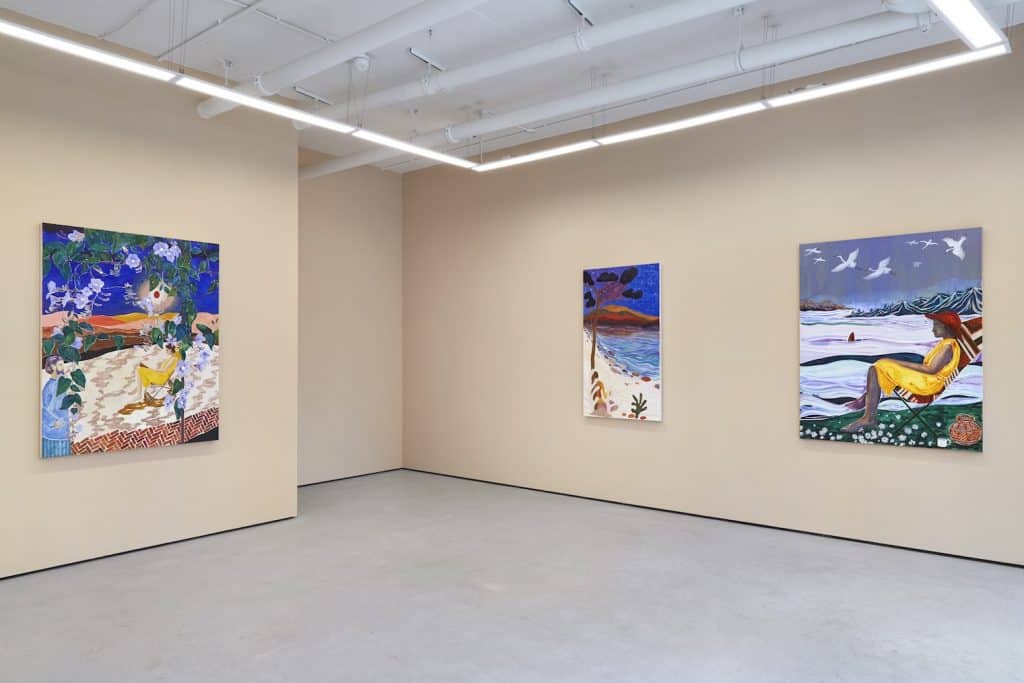
As part of a material practice that incorporates watercolour and gouache works on paper and woodcut prints, your paintings frequently demonstrate the use of thinned layers of oil paint that allows the pigment to soak and stain the canvas or linen. What is your preferred approach to the physical painting process? And do your paper works directly inform your paintings?
I like to play a part in every aspect of making the work. Stretching the canvas, priming it, this all takes time but in the process, I begin to feel connected to the surface, I can build it up in a way that will give me the tension, fluidity and roughness that I want. While I am priming I start to get a feel for the atmosphere of the painting I might make, if it might be dank and dark or bright and vivid. I might have a new colour I want to use or an idea for a method I want to try. It gives me time to start formulating the painting in a tactile way; something I don’t think I would have if I bought a readymade and primed canvas. That materiality is important to me; I want it to look like it has been made by a pair of hands, to have the passage of time, the process, the building up and rubbing out. I am less interested in a slick finish. This desire for things to remain true to the material and retain a sense of the handmade comes into both the printwork and paperwork also. I make hand-stained paper to collage with, use printing tools in canvas painting, mix oil and water knowing it doesn’t really work and recently have added handmade frames to my paintings.
The paperwork does of course inform the oil painting, sometimes directly and sometimes less so. At times I work directly from a paper piece, bringing the image across onto canvas. Other times it might just be the way wet watercolour pools on the paper that I try to emulate in oil. Be it on paper or canvas I try to not have a set way of working; I have various primers I might use on different paintings that give me different results, some paintings are more stained and some keep the brush marks more surface; I like to try things out and see where the painting ends up.
You’ve maintained a home studio since the birth of your first child a few years ago, and have mentioned previously your toddler’s ability to notice “things you might have otherwise missed” when in your garden. In what ways has motherhood informed or influenced your practice, if at all?
Becoming a mother has changed a lot about my work but mostly in the process as opposed to the imagery, although figures of women and young children are inevitably creeping in. For a start when I first became pregnant I changed a lot of my materials, remaining able to work in oil paint but in a much less toxic way, and also leaning more into my paper works. When my first child was 3 months old I moved out of my studio in Hackney Wick and into a home studio, as the studio I had just wasn’t practical on many levels. I had my second child quite soon after so remained working from home for the years that they were both very young. My home studio was of course much smaller than my previous one so this, in turn, changed the way I made paintings. I could work on fewer at a time and was often only able to work in short moments while my children napped or even whilst wearing one in a sling when they were small. Whereas I used to have a stretch of time before me in the studio I only had short windows, so I became more structured for a while, planning which section of a painting I was going to work on in each short time frame.
A year ago I moved out of my home studio and back into another traditional studio space. I really appreciate having the separation of home and studio and having a quiet room to myself to work in. I have more time again to approach the work, and can leave things out on the floor, wet and soaked in oil, and not worry that they will get played with or be a hazard to small people!
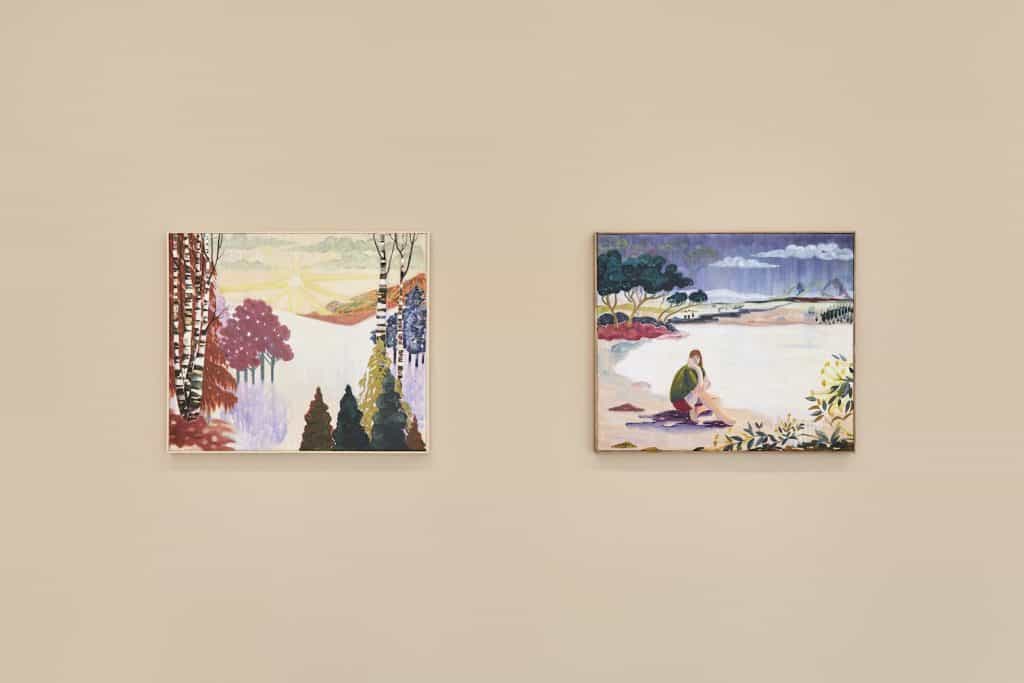
A self-penned poem yourself accompanied the announcement of your current solo exhibition, and your previous solo exhibition ‘The Sun Long Night’ took its title from a Dylan Thomas poem. Do poetry and literature play a large part in your life and work?
I write in my rather limited free time but I never share it with people. I am quite private about it and it actually felt quite exposing to use a poem of my own for the text. There is definitely something interesting about the challenge of presenting a different facet of my creativity and I felt like I was at a point where I was willing to do that. I find the flow and construction of poetry really fascinating, the reduction of something greater, the distilling down of a selected word. I love choosing the title for each painting, it is a chance to take just a few words that can be the start of something larger and unsaid. The title of the current exhibition, All paths lead somewhere, is the title of a painting in the show and in turn is also a line from another poem I have written. Be it my writing or someone else’s, be it a book, film, poem or lyric, I find writing often sits alongside my painting in a quiet way; the shadow to the painting’s sun.
Finally, your current solo exhibition ‘All paths lead somewhere’, your third at Lychee One Gallery in London Fields, features a new selection of paintings made in the last twelve months. Could you give some insight into the artworks currently on show?
It goes without saying that the last twelve months have been upside down for all of us, and it was an interesting time for me personally because the lockdown exactly coincided with the studio move I mentioned previously.
There is a definite distillation in these paintings. In lockdown I missed being able to leave my local area, I missed nature and it, therefore, became even more relevant in the work. My colour palette shifted, there is more red, ochre and yellow than before. Perhaps the paintings became a little less dreamy and more like a memory, more tethered to reality. In part, I escaped my surroundings mentally and dipped into the scenes I painted, and when the time of this show approached I knew how I wanted it to feel. I wanted to give people the sense that, in visiting the show, they have stepped outside of Hackney into a room where all the walls are soft, the colour of an Italian villa or an old dried wall by a warm path. I hoped the paintings would feel transportive. If we are not able to visit other places or easily get out into nature, then for a short time this body of work might in some small way be a slice into that. I wanted the show to feel welcoming and inviting, for the colours to be rich and the images to feel vibrant but still; if in some way I have achieved that then I am happy.

